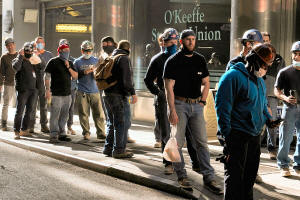U.S. hiring takes big step back as businesses scramble for workers, raw
materials
 Send a link to a friend
Send a link to a friend
 [May 08, 2021] By
Lucia Mutikani [May 08, 2021] By
Lucia Mutikani
WASHINGTON (Reuters) - U.S. job growth
unexpectedly slowed in April, likely curbed by shortages of workers and
raw materials as rapidly improving public health and massive government
aid fueled an economic boom.
The Labor Department's closely watched employment report on Friday,
which showed a plunge in temporary help jobs - a harbinger for future
hiring - as well as decreases in manufacturing, retail and courier
services employment, sparked a heated debate about the generosity of
unemployment benefits.
The enhanced jobless benefits, including a government-funded $300 weekly
supplement, pay more than most minimum wage jobs. The benefits were
extended until early September as part of a $1.9 trillion COVID-19
pandemic relief package approved in March. Montana and South Carolina
are ending government-funded pandemic unemployment benefits for
residents next month.

Economists say some workers could still be fearful of returning to work
even as all adult Americans are now eligible to receive COVID-19
vaccinations. Others also cited problems with child care as in-person
classes remain limited in many school districts. Labor and input
shortages have been well documented by business surveys.
"The employment gain is understated in part because of the generous
largess from Washington," said Sung Won Sohn, a finance and economics
professor at Loyola Marymount University in Los Angeles. "Short-staffed
restaurant owners are working overtime, truck drivers are impossible to
find even after a hefty increase in hourly wages and loading docks at
warehouses are keeping trucks idle as there aren't enough workers."
Nonfarm payrolls increased by only 266,000 jobs last month. Data for
March was revised down to show 770,000 jobs added instead of 916,000 as
previously reported. Economists polled by Reuters had forecast payrolls
would advance by 978,000 jobs.
That left employment 8.2 million jobs below its peak in February 2020.
The U.S. Chamber of Commerce urged the government to scrap the weekly
unemployment subsidy, but the White House dismissed complaints the
generous unemployment checks were causing worker shortages.
"It's clear that there are people who are not ready and able to go back
into the labor force," Treasury Secretary Janet Yellen said. "I don't
think the addition to unemployment compensation is really the factor
that is making a difference."
Twelve months ago, the economy purged a record 20.679 million jobs as it
reeled from mandatory closures of nonessential businesses to slow the
first wave of COVID-19 infections. That plunge could have thrown off the
model that the government uses to adjust the data for seasonal
fluctuations, resulting in the April payrolls number being below
forecasts.
Unadjusted payrolls increased by 1.089 million jobs after rising by
1.176 million in March.
"We have warned frequently that the COVID-19 shock last spring would
echo through the seasonally adjusted data and cause significant
volatility," said Scott Ruesterholz, portfolio manager at Insight
Investment in New York. "That is likely what is happening with this
report."
The report did not change expectations that the economy entered the
second quarter with strong momentum and was on track for its best
performance this year in almost four decades. Timely labor market
indicators, like new claims for jobless benefits, which last week
dropped below 500,000 for the first time since the pandemic started,
suggest payrolls will pick up.
[to top of second column] |

Construction workers wait in line to do a temperature test to return
to the job site after lunch, amid the coronavirus disease (COVID-19)
outbreak, in the Manhattan borough of New York City, New York, U.S.,
November 10, 2020. REUTERS/Carlo Allegri

Stocks on Wall Street were trading higher. The dollar was weaker against a
basket of currencies. Prices of longer-dated U.S. Treasuries fell.
ROBUST DEMAND
With more Americans vaccinated, many states have lifted most restrictions on
businesses. That, together with $1,400 stimulus checks sent to qualifying
households in March, unleashed pent-up demand. Supply chains were already
strained by the shift in demand toward goods from services during the pandemic.
The burst in demand contributed to the economy's 6.4% annualized growth pace in
the first quarter, the second-fastest since the third quarter of 2003. With
households sitting on at least $2.3 trillion in excess savings, economists were
steadfast in their expectations for double-digit growth this quarter.
"The only thing keeping job gains down is supply, not demand," said Joel Naroff,
chief economist at Naroff Economics in Holland, Pennsylvania. "The economy is
racing forward and that is what we should focus on."
Leisure and hospitality gained 331,000 jobs in April, with hiring at restaurants
and bars accounting for more than half of the increase. Government employment
picked up as some school districts hired more teachers for in-person learning.
But temporary help services employment dropped by 111,400 jobs. Manufacturing
employment fell by 18,000 jobs, with payrolls at motor vehicle manufacturers
dropping 27,000. A global semiconductor chip shortage has forced production
cuts.

In the transportation and warehousing industry, employment for couriers and
messengers fell by 77,000. Retail employment dropped by 15,300 jobs.
Construction payrolls were flat. With workers scarce, employers boosted wages
and increased hours for employees. Average hourly earnings jumped 0.7% after
dipping 0.1% in March. The average workweek rose 0.1 hour to 35 hours.
The unemployment rate rose to 6.1% in April from 6.0% in March as 430,000 people
entered the labor force. The jobless rate has been understated by people
misclassifying themselves as being "employed but absent from work."
Without this misclassification, the unemployment rate would have been 6.4% in
April. The labor force participation rate, or the proportion of working-age
Americans who have a job or are looking for one, climbed to 61.7% from 61.5% in
March. It was, however, lifted by men. Women, who account for most of the at
least 4 million people still outside the labor force, dropped out.
That could bolster President Joe Biden's plan to spend another $4 trillion on
education and childcare, middle- and low-income families, infrastructure and
jobs. It also supports the Federal Reserve's ultra-easy monetary policy stance.
"The road to full employment may be a bit longer than we all thought," said
Scott Anderson, chief economist at Bank of the West in San Francisco.
(Reporting by Lucia Mutikani; additional reporting by Steve Holland; Editing by
Chizu Nomiyama and Paul Simao)
[© 2021 Thomson Reuters. All rights
reserved.] Copyright 2021 Reuters. All rights reserved. This material may not be published,
broadcast, rewritten or redistributed.
Thompson Reuters is solely responsible for this content. |